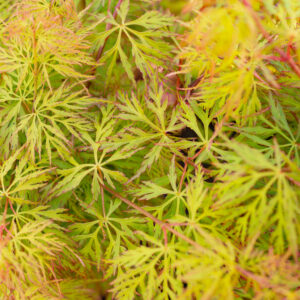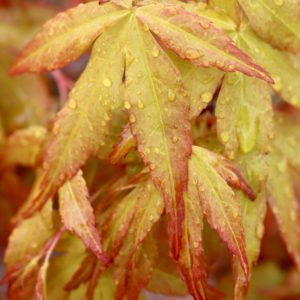Acer palm. Little Princess
Price range: €150.00 through €195.00
Frequently Bought Together


Description
Quick Facts
- Common Name: Little Princess Japanese Maple, Dwarf Japanese Maple
- Botanical Name: Acer palmatum ‘Little Princess’
- Plant Type: Deciduous shrub
- Mature Height: 1-1.5m
- Mature Spread: 1-1.5m
- Flowering Period: April to May
- Flower Colour: Small purple-red flowers (insignificant)
- Foliage: Deeply dissected palmate leaves, bright green turning brilliant orange-red in autumn
- Hardiness: RHS H5 (hardy in most areas)
- Soil Requirements: Moist, well-drained, slightly acidic to neutral
- Aspect: Partial shade to full sun (with shelter)
- Maintenance: Low
Description
Discover the enchanting beauty of Acer palmatum ‘Little Princess’, the delightful Dwarf Japanese Maple that brings exceptional elegance, spectacular autumn colour, and perfect proportions to your garden with its compact size and exquisitely dissected foliage. This outstanding ornamental maple offers remarkable qualities—a naturally compact, mounded form that remains small and manageable, reaching only 1-1.5m in height and spread even at maturity, deeply dissected, lace-like leaves in fresh bright green that create delicate texture and graceful presence throughout spring and summer, spectacular autumn transformation when the foliage ignites in brilliant shades of orange, scarlet, and crimson, and slow, controlled growth perfect for small gardens, rock gardens, containers, and intimate spaces, making this one of the most charming and versatile dwarf Japanese maples for creating oriental elegance, seasonal drama, and living sculpture in even the smallest Irish gardens.
Throughout spring and summer, this captivating maple displays its characteristic deeply dissected palmate leaves with 5-7 narrow, pointed lobes that are cut almost to the base, creating an exquisite lace-like or feathery texture. The foliage emerges in spring in fresh bright green with hints of bronze, maturing to a lovely mid to bright green that creates soft, delicate texture throughout the growing season. The naturally compact, mounded habit creates elegant rounded form with dense, twiggy branching that becomes increasingly refined with age. New growth appears in slightly lighter green tones, creating subtle colour variation. In spring, small purple-red flowers appear but are largely hidden by the emerging foliage. In autumn, the foliage transforms into a spectacular display of brilliant orange, scarlet, crimson, and red—one of the finest autumn shows of any dwarf maple—before the leaves fall to reveal the intricate branching structure for winter.
This remarkable cultivar is a Japanese maple of the Dissectum Group, selected specifically for its exceptionally compact size and refined proportions. ‘Little Princess’ is aptly named for its petite stature and regal elegance. Hardy and adaptable once established, this maple thrives in Irish conditions when given appropriate shelter from harsh winds and late spring frosts which can damage emerging foliage. The extremely slow growth rate and naturally compact form mean this maple requires virtually no pruning and remains perfectly proportioned for decades. Ideal for gardeners seeking the elegance of Japanese maples in limited spaces.
Create stunning compositions by planting as jewel-like specimen features in small gardens, courtyard gardens, or intimate spaces where every plant must earn its place. Magnificent in rock gardens, Japanese-inspired gardens, or contemporary minimalist designs. Exceptional in containers on patios, terraces, balconies, or beside entrances where the compact size and refined form create elegant focal points at eye level. Works beautifully in mixed borders with low-growing perennials, or as understory planting beneath larger trees. Perfect for bonsai-style container displays or raised beds. Plant where the autumn colour can be appreciated up close and where shelter from harsh winds is provided.
Caragh Garden Notebook
Planting: Space plants 1.5-2m apart if planting multiples, or allow 1.5m for specimen placement to accommodate the compact mature spread. Plant container-grown specimens year-round, though spring or early autumn is ideal. Dig holes twice the width of the root ball and incorporate generous amounts of ericaceous compost or organic matter. Plant at the same depth as the container—avoid planting too deeply. Choose sheltered positions protected from harsh winds, cold easterly winds, and late spring frosts. Water thoroughly and mulch generously with organic matter or composted bark.
Soil Preparation: Thrives in moist, well-drained, slightly acidic to neutral soil with pH 5.5-7.0. Prefers fertile, humus-rich, moisture-retentive conditions enriched with generous amounts of organic matter or ericaceous compost. Dislikes waterlogged, very dry, shallow chalky, or alkaline soils. Requires excellent drainage—Japanese maples are susceptible to root rot in poorly drained conditions. Best growth and autumn colour occur in partial shade with shelter from harsh winds, though tolerates full sun in cooler areas if soil moisture is consistent and shelter is provided.
Container Growing: Absolutely ideal for container growing—the compact size, slow growth, and refined proportions make this one of the best Japanese maples for long-term container cultivation. Use containers minimum 40-50cm diameter (larger is better for long-term health). Use ericaceous or soil-based compost with added organic matter. Water regularly and consistently—never allow to dry out completely, but ensure excellent drainage. Feed in spring with slow-release balanced fertiliser. Protect containers from hard frost in winter by wrapping, moving to sheltered locations, or insulating. Repot every 3-5 years in early spring. Container-grown specimens can remain healthy and beautiful for many years with proper care.
Seasonal Care: Requires minimal to no pruning—the naturally compact, mounded form develops perfectly without intervention. Remove only dead, damaged, or crossing branches in late summer when sap flow is reduced—avoid winter and early spring pruning as maples bleed sap heavily. Never top or shear as this destroys the characteristic refined form. Remove any green-leaved reversions immediately if they appear. Apply slow-release balanced or ericaceous fertiliser in early spring. Mulch annually with organic matter or composted bark to retain moisture and suppress weeds. Water during dry spells—consistent moisture is essential, especially for container-grown specimens. Protect from late spring frosts with fleece if possible.
Propagation: Cannot be propagated from seed as this is a named cultivar that will not come true from seed. Professional propagation is by grafting onto Acer palmatum rootstock. Softwood cuttings can be attempted in early summer but success is variable and requires specialist facilities with mist propagation. Home gardeners should purchase nursery-grown grafted specimens for guaranteed quality, reliable compact size, and characteristic refined form.
This charming beauty is absolutely delightful—that deeply dissected lace-like foliage in fresh bright green creates such delicate, refined elegance! The naturally compact size is perfect for small gardens and containers, and that spectacular autumn transformation to brilliant orange and scarlet is simply stunning. Slow-growing, perfectly proportioned, and requires virtually no pruning. A true little princess indeed—petite, elegant, and absolutely regal!





